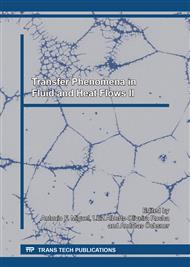[1]
Mariani, L.M., Simulação de Incêndio Utilizando a Ferramenta Computacional Fire Dynamics Simulator: Teste de Hipótese de Incêndio Ocorrido em Samambaia-DF, Trabalho de Conclusão de Curso (Especialização em Perícia de Incêndio e Produção de Provas Judiciais), Curso de Especialização em Perícia de Incêndio e Produção de Provas Judiciais, Universitário Euroamericano (UNIEURO), Brasília, (2009).
DOI: 10.11606/d.18.2018.tde-27082018-123952
Google Scholar
[2]
Kletz, T.A., What Went Wrong: Case Histories of Process Plant Disasters, 4. ed., Gulf Publishing Company, Massachusetts, (1999).
DOI: 10.1080/00908318708945522
Google Scholar
[3]
Fontenelle, F.M. A, Análise Térmica em Estruturas de Tanques de Armazenamento de Etanol em Situação de Incêndio, Dissertação (Mestrado em Engenharia Civil), Programa de Pós-graduação em Engenharia Civil, Universidade Federal do Rio de Janeiro (UFRJ), Rio de Janeiro, (2012).
DOI: 10.52547/rbmb.10.2.314
Google Scholar
[4]
Leite, R.M., Rodrigues, E.E.C., Centeno, F.R., Estudo experimental de incêndio em tanques de armazenamento de gasolina comum em escala reduzida, 3º Congresso Ibero-Latino-Americano sobre Segurança Contra Incêndio (CILASCI), Porto Alegre, RS, Brasil, (2015).
DOI: 10.24840/978-972-752-272-9_0341-0351
Google Scholar
[5]
Stephen B. Pope, Turbulent Flows, Cambridge University Press, (2000).
Google Scholar
[6]
Ryder, N. L., Sutula, J. A., Schemel, C. F., Hamer, A. J., Brunt, V. V., Consequence modeling using the fire dynamics simulator, Journal of Hazardous Materials 115 (2004) 149-154.
DOI: 10.1016/j.jhazmat.2004.06.018
Google Scholar
[7]
McGrattan, K., Hostikka, S., Floyd, J., Baum, H., Rehm, R., Fire Dynamics Simulator (Version 5) Technical Reference Guide. NIST Special Publication 1018-5, (2007).
DOI: 10.6028/nist.sp.1018-5
Google Scholar
[8]
Patankar, S.V., Numerical heat transfer and fluid flow, Hemisphere, New York, (1980).
Google Scholar
[9]
Versteeg, H.K., Malalasekera, W., An introduction of computational fluid dynamics: the finite volume method, 2nd ed., Prentice Hall, USA, (2007).
Google Scholar
[10]
Deardorff, J. W., Numerical Investigation of Neutral and Unstable Planetary Boundary Layers, Journal of Atmospheric Sciences 29 (1972) 91–115.
DOI: 10.1175/1520-0469(1972)029<0091:nionau>2.0.co;2
Google Scholar
[11]
Petróleo Brasileiro S.A., Gasolina Comum Tipo C: Certificado de Ensaio, no: 4225550-15 R, Canoas, (2015).
Google Scholar
[12]
Petróleo Brasileiro S.A., Gasolina Comum Tipo C: Ficha de Informação de Segurança de Produto Químico – FISPQ, no: Pb0031_p, Rio de Janeiro, (2015).
Google Scholar
[13]
Petróleo Brasileiro S.A., Gasolina Comum Tipo A: Ficha de Informação de Segurança de Produto Químico – FISPQ, no: Pb0029_p, Rio de Janeiro, (2014).
Google Scholar
[14]
Stroup, D., Lindeman, A., Verification and validation of selected fire models for nuclear power plant applications. NUREG-1824, supplement 1, United States Nuclear Regulatory Commission, Washington, DC, (2013).
Google Scholar
[15]
Babrauskas, V., Heat Release Rates in Fires, 1. ed. E&FN Spon: Londres, (1992).
Google Scholar
[16]
Zukoski, E., Cetegen, B., Kubota, T., Visible Structure of Buoyant Diffusion Flames, 20th Symposium International on Combustion, The Combustion Institute, Pennsylvania, (1984).
DOI: 10.1016/s0082-0784(85)80522-1
Google Scholar
[17]
Thomas, P.H., The Size of Flames from Natural Fires, 9th Symposium International on Combustion, The Combustion Institute, Pennsylvania, (1962).
Google Scholar
[18]
Heskestad, G., Fire Plumes, Fire Height, and Air Entrainment. Seção 2, Capítulo 1, SFPE Handbook of Fire Protection Engineering, 3 ed. National Fire Protection Association: Quincy, Massachusetts, (2002).
DOI: 10.1007/978-1-4939-2565-0_13
Google Scholar


